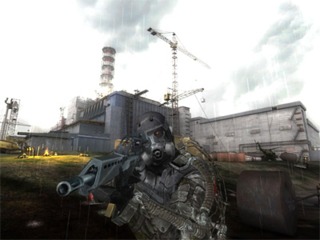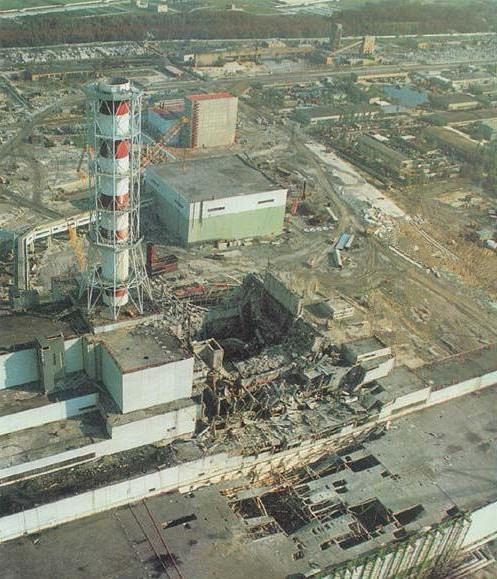 A Stalker in the shadow of Chernobyl.
A Stalker in the shadow of Chernobyl.The Chernobyl Nuclear Power Plant, formerly known as the V.I. Lenin Nuclear Power Station, is a nuclear power plant consisting of four nuclear reactors, located eleven miles (eighteen kilometers) northwest of the city of Chernobyl. Construction of the plant began in 1970, in conjunction with the construction of Pripyat. Reactors 1 through 4 were commissioned in 1977, 1978, 1981 and 1983 respectively, with each reactor capable of producing 1000 megawats of electricity.
Already flawed by the RBMK-1000 design that the Soviet Union used at the time, reactors three and four were not designed with as robust a set of safety features, particularly the lack of any extra protection between the control room and the reactor, unlike the thick concrete that separates the control rooms of reactors one and two.
In 1982, reactor one suffered a partial core meltdown, with the extent of the accident kept from the public. The reactor was repaired and resumed operation in a few months.
 Chernobyl Reactor Four right after the accident.
Chernobyl Reactor Four right after the accident.1986 saw what is now simply known as the Chernobyl disaster. On Saturday, April 26, 1986, a mismanaged safety test and failure to activate the cooling mechanisms in reactor 4 resulted in the worst nuclear disaster in human history. The reactor was completely destroyed by both a steam explosion and a fuel explosion, blowing a hole in the building and pushing the lid off the reactor, exposing radioactive material. The resulting radioactive fallout contaminated much of Ukraine and Belarus, with radiation riding the prevailing winds and spreading all across Europe, and small traces even reaching the eastern United States.
Everything within a nineteen mile (thirty kilometer) radius of the facility was deemed uninhabitable, and several hundred thousand people were evacuated from the area. Vehicles used in the evacuation and cleanup were left in the zone as well, forming a sort of automotive grave yard. As a result of this accident, the construction of reactors five and six were halted, and the construction cranes stand next to them to this day. In order to contain further radioactive fallout, a large steel shelter was built over the ruins of reactor four. Today, the shelter is considered unstable, and fear that an earthquake or similar disaster could damage the existing structure has spurred a search for a replacement. On September 17, 2007, a contract was signed with French construction consortium Novarka to construct a 190x200 meter arch structure to cover and replace the existing shelter, with the project expected to be completed by 2013.
In 1991, reactor two's turbine four suffered a hydrogen leak, resulting in a fire that damaged the turbine and the turbine hall's roof. The reactor was shut down after this accident.
The shutdown of the remaining reactors occurred in two stages, with reactor one going offline in 1996 and reactor three shut down on December 15, 2000. Despite their shutdown, people continue to work at the plant, monitoring the nuclear fuel until sufficient storage can be constructed and the plants can be properly decommissioned.
 Reactor Four today, encased in its steel shelter.
Reactor Four today, encased in its steel shelter.The remains of reactor four will be radioactive for quite a long while. The Caesium-137 which is responsible for most of the gamma radiation at the site has a half-life of thirty years. Estimates are that the gamma ray dosage at the reactor building will return to the normal background level within approximately 300 years. However, longer-lived alpha emitters mean that the soil and many surfaces in and around the plant are likely contaminated with longer-lasting materials such as plutonium and americium, meaning that it may well take thousands of years for the area that houses reactor four to be safe for human habitation, barring decontamination by humans when the area is safe enough to begin proper deconstruction of the facility.
Log in to comment